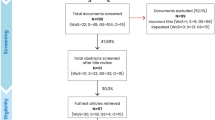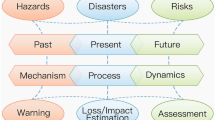Abstract
Timely, effective delivery of relief resources to the sufferers in a natural disaster is quite crucial. All governments especially those having high risk of natural disasters must have a comprehensive and implementable plan to suitably manage humanitarian issues after a natural disaster occurs. They should construct sufficient facilities and prepare and store enough relief items (e.g., tents, medical packages, and meals) to be able to quickly respond to necessary needs of injured and homeless people; otherwise, it might lead to humanitarian crises with high numbers of casualties. In this study, we extend the mathematical two-stage stochastic optimization model proposed by Mete and Zabinsky (Int J Prod Econ 126:76–84, 2010) simultaneously considering two phases: pre- and post-disaster. All decisions pertinent to the pre-disaster phase, such as the locations of warehouse and pre-positioned relief items, should be taken in the first stage; however, other decisions pertinent to the post-disaster phase, such as the allocations of warehouses to the demanding points are taken in the second stage. In this study, we consider bi-directional relations between warehouses, which can increase the flexibility of the constructed network to handle the needs of injured people in a shorter time interval. Furthermore, whereas the relief process should be implemented within a specific time interval (e.g., 3 days), our extended optimization model is constructed for a multi-period and multi-product situation. We construct the extended model based on a professional report prepared by the Japanese International Cooperation Agency in a study of the seismic micro zoning of Tehran on April 13, 1999. The respective data in this report has also been updated based on the reports of Tehran Municipality to be matched with the current situation of Tehran. The results of our extended multi-period model for the respective real case study in this paper verify suitable responses and better services to the affected areas compared to what are provided through the respective single-period optimization model.



Similar content being viewed by others
Notes
Tehran Institution of Crisis Prevention and Management.
Expected value of perfect information.
Value of stochastic solution.
References
Afshar, A., & Haghani, A. (2012). Modeling integrated supply chain logistics in real-time large-scale disaster relief operations. Socio-Economic Planning Sciences, 46, 327–338.
Akkihal, A. R. (2006). Inventory pre-positioning for humanitarian operations. Doctoral dissertation, Massachusetts Institute of Technology.
Balcik, B., & Beamon, B. M. (2008). Facility location in humanitarian relief. International Journal of Logistics, 11, 101–121.
Birge, J. R., & Louveaux, F. (2011). Introduction to stochastic programming. Berlin: Springer.
Brotcorne, L., Laporte, G., & Semet, F. (2003). Ambulance location and relocation models. European Journal of Operational Research, 147, 451–463.
Gunn, S. W. A. (2003). The language of disasters: A brief terminology of disaster management and humanitarian action. In Basics of international humanitarian missions (pp. 35–46). New York: Fordham University Press/Center for International Health and Cooperation.
Hu, C. L., Liu, X., & Hua, Y. K. (2016). A bi-objective robust model for emergency resource allocation under uncertainty. International Journal of Production Research, 54, 7421–7438.
Huang, K., Jiang, Y., Yuan, Y., & Zhao, L. (2015). Modeling multiple humanitarian objectives in emergency response to large-scale disasters. Transportation Research Part E: Logistics and Transportation Review, 75, 1–17.
Huang, X., & Song, L. (2016). An emergency logistics distribution routing model for unexpected events. Annals of Operations Research, 1–17.
JICA (Japan International Cooperation Agency). (2000). The Study on Seismic Microzoning of the Greater Tehran Area in the Islamic Republic of Iran. Center for Earthquake and Environmental Studies of Tehran (CEST), Pacific Consultants International OYO Corporation, Tehran, Municipality
Liberatore, F., Scaparra, S., & Daskin, M. (2011). Hedging against disruptions with ripple effects in location analysis. Omega, 40, 21–30.
Mete, H. O., & Zabinskyl, Z. B. (2010). Stochastic optimization of medical supply location and distribution in disaster management. International Journal of Production Economics, 126, 76–84.
Najafi, M., Eshghi, K., & Dullaert, W. (2013). A multi-objective robust optimization model for logistics planning in the earthquake response phase. Transportation Research Part E, 49, 217–249.
Naji-Azimi, Z., Renaud, J., Ruiz, A., & Salari, M. (2012). A covering tour approach to the location of satellite distribution centers to supply humanitarian aid. European Journal of Operational Research, 222, 596–605.
Ozdamar, L., Ekinci, E., & Kucukyazici, B. (2004). Emergency logistics planning in natural disasters. Annals of Operations Research, 129, 217–245.
Paul, J. A., & Hariharan, G. (2012). Location–allocation planning of stockpiles for effective disaster mitigation. Annals of Operations Research, 196, 469–490.
Rawls, C. G., & Turnquist, M. A. (2010). Pre-positioning of emergency supplies for disaster response. Transportation Research Part B: Methodological, 44, 521–534.
Rawls, C.G., & Turnquist, M.A. (2012). Pre-positioning and dynamic delivery planning for short-term response following a natural disaster. Socio-Economic Planning Sciences, 46, 46–54.
Sheu, J. B. (2007). An emergency logistics distribution approach for quick response to urgent relief demand in disasters. Transportation Research Part E: Logistics and Transportation Review, 43, 687–709.
Tzeng, G. H., Cheng, H. J., & Huang, T. D. (2007). Multi-objective optimal planning for designing relief delivery systems. Transportation Research Part E: Logistics and Transportation Review, 43, 673–686.
Yang, F., Yuan, Q., Du, S., & Liang, L. (2014). Reserving relief supplies for earthquake: A multi-attribute decision making of China Red Cross. Annals of Operations Research, 247, 759–785.
Zanjirani Farahani, R. Z., Asgari, N., & Davarzani, H. (2009). Supply chain and logistics in national, international and governmental environment: Concepts and models. Berlin: Springer.
Zheng, Y. J., & Ling, H. F. (2013). Emergency transportation planning in disaster relief supply chain management: A cooperative fuzzy optimization approach. Soft Computing, 17, 1301–1314.
Author information
Authors and Affiliations
Corresponding author
Appendix
Appendix
See Tables 19, 20, 21, 22, 23, 24, 25 and 26.
Rights and permissions
About this article
Cite this article
Mahootchi, M., Golmohammadi, S. Developing a new stochastic model considering bi-directional relations in a natural disaster: a possible earthquake in Tehran (the Capital of Islamic Republic of Iran). Ann Oper Res 269, 439–473 (2018). https://doi.org/10.1007/s10479-017-2596-y
Published:
Issue Date:
DOI: https://doi.org/10.1007/s10479-017-2596-y




